PART ONE: A TENT IN A FOREST
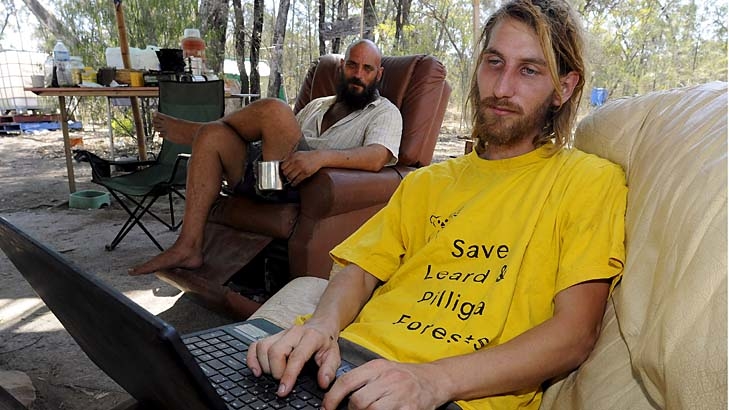
On August 5th, 2012, Jono Moylan and Murray Dreschler pitched a couple of tents not far from the road in the Leard State Forest, near Boggabri in Western NSW. It was an inauspicious beginning to what would become a long and eventful journey.
They were there to try to stop the forest being bulldozed for the construction of Whitehaven Coal’s Maules Creek mine; to work with farmers and Traditional Owners whose land would be affected; to hopefully build a movement of people taking direct action to stop new coal mines being built in Australia. They called themselves Frontline Action on Coal.
It was a significant moment for Australian environmental protest. Forest blockade camps were nothing new, but this was the first time those blockading techniques developed in the forest – the lock-ons, treesits and tripods – would be used to try to stop a coal mine. The move was an acknowledgement of climate change as the single biggest threat to ecosystems everywhere.
In time others joined Muzz and Jono in that forest, and in fact took the seed they had planted and cultivated it across the country. FLAC became one of the longest lasting and highest profile direct action groups in the country – a collective that has maintained resistance to the coal industry for a decade, and trained and inspired countless activists. Thousands of people have been through the various FLAC camps in the ten years since then, and many hundred arrested disrupting the destructive business of the fossil fuel industry.
How do you measure the effect we have had in that time? We spent years on two major campaigns, and in the end both Whitehaven and Adani managed to build their mines despite our best efforts. But that’s not where the story ends. There’s also the broader influence on the fossil fuel industry we have resisted and exposed as the plant-wrecking mercenaries they are; and on the Australian environmental movement which FLAC has been such a vital part of. But who could ever measure influence on all those individuals who have come through the camps? Those folks involved in starting that Leard Forest camp could never have predicted what would come from their act of faith. Same story for every lock-on and treesit since. We never know what the effect of our actions will be, but can always be certain that getting together and doing what we can has a better chance of protecting our climate than sitting around waiting for someone else to do it.
When we are in campaign mode we are forever planning and strategising for the future. We don’t get much chance to look back at what we have achieved or analyse what the fruits of those efforts have been. But in this article, as FLAC celebrates our 10th birthday, that’s what we are going to do.
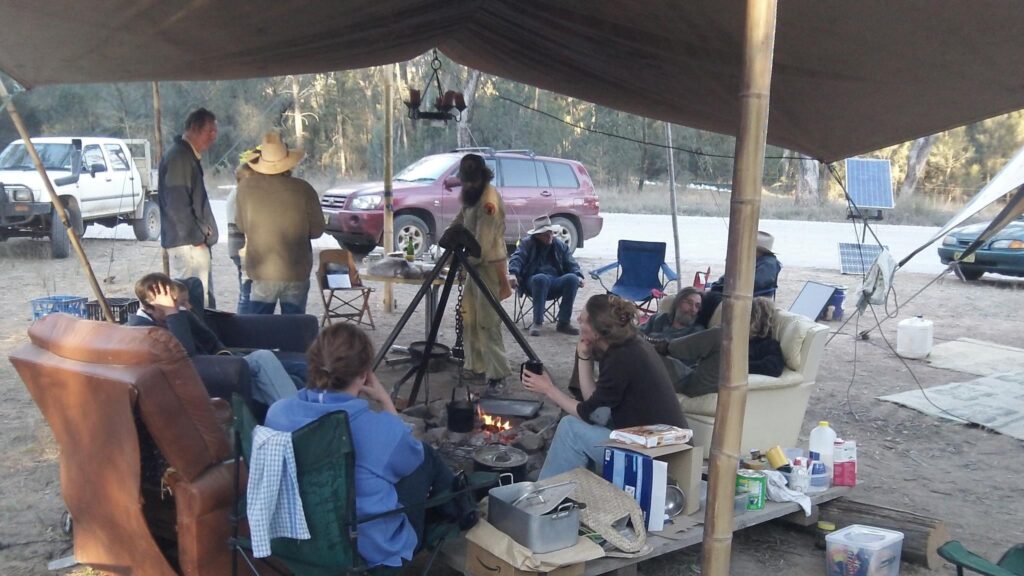
.
PART TWO: AND… ACTION!
The first FLAC direct action was done by Dan and Scotty abseiling off Idemitsu’s coal loader in September 2012. There were plenty more after that – disrupting every stage of mine construction and operation, using every blockade tactic you could imagine. But for one memory to encapsulate FLAC’s many many blockade actions, let’s go back to Idemitsu’s coal loader – to Dani and Kat suspending themselves as twin batgirls and temporarily putting it out of operation.
I’ve chosen this one for a few reasons. One is because for the Maules Creek campaign, bats were FLAC’s mascot. There were many bat species whose habitat was threatened by the destruction of the forest. We all loved it when ecologist Phil Spark would come to camp and show us some of the very cute species we were trying to protect. But bats were a good match for FLAC in other ways – they fly unobserved around the bush at night, hanging themselves in improbable locations.
I’ve also picked this because it was a very staunch and highly organised action, requiring plenty of courage and a lot of mental and physical skill – and it was done by two women. At FLAC we have never believed anyone’s gender defines them, and we have been blessed with so many talented and driven women in all fields of the campaign – rigging treesits and tripods, media and photography, organising and facilitation, and of course putting one’s body in the way of our planet’s destruction. There is no way FLAC could have achieved what we have in the last decade without all the amazing women making full use of their abilities and passions.
But this action represents one more key attribute of FLAC’s direct action efforts. We don’t just disrupt work on coal mines. Frequently we have disrupted that work in creative ways, with some artistic flair and a bit of cheeky humour. We’ve had people dressed as all variety of land and sea creatures, a human disco ball atop a tripod, giant props, witty and pretty banners, and much more. And why not? Protesting against climate destruction isn’t just necessary for the planet’s survival – it’s also fun, dramatic and beautiful. FLAC’s actions many times have demonstrated that.
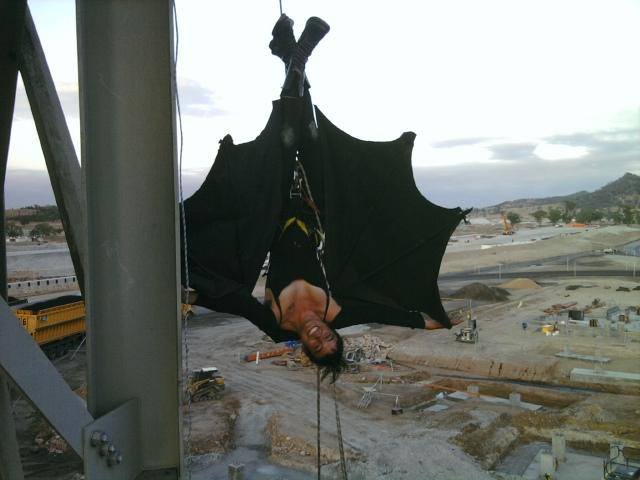
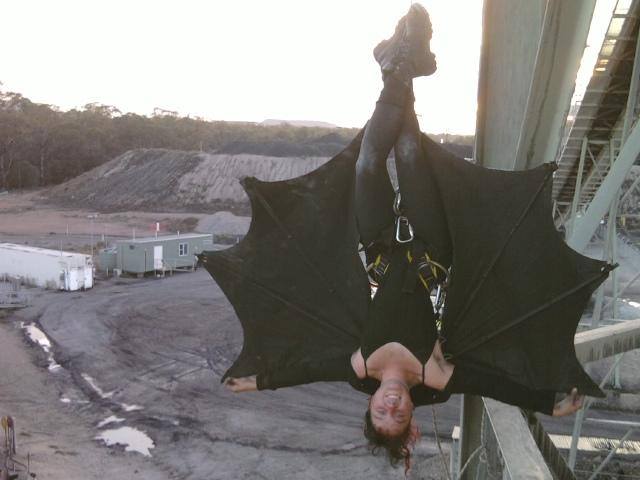
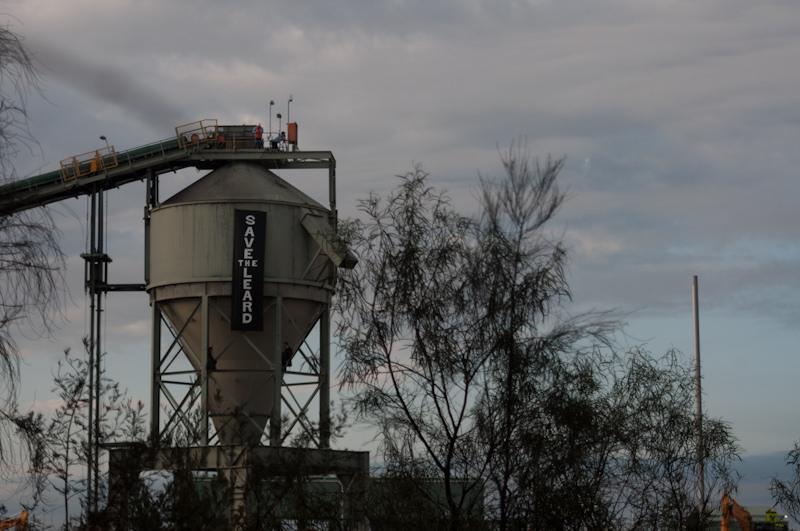
.
PART THREE: GET A JOB!
“Get a job!” is a phrase that has been thrown at many FLAC personnel over the years. It’s unoriginal, but also shows no understanding of just how much work goes into what we do.
Blockade actions require a lot of sweat, skill, courage and sacrifice. They usually involve detailed planning and training, waking up early or getting no sleep at all, a long walk through the bush or a hasty dash to dodge security, then enduring freezing cold or scorching sun while locked to machinery – sometimes as a sitting target to be abused by workers or manipulated by cops. And while those who destroy our planet get to pocket a sizable wage for their efforts; all the work at FLAC is done totally for free, out of love.
This has been true of FLAC actions everywhere over the last decade, but for one archetype let’s go back to winter 2014. The council had kicked us out of the forest where we had been camped for 18 months, but local farmer Cliff Wallace in an incredible act of generosity offered to host us on his property “Wando”. By winter, Whitehaven had started clearing land and we’re tearing down that forest at a rapid rate despite the fact many animals were hibernating in tree hollows or otherwise unable to escape.
Police had set up a permanent roadblock outside Wando (one journalist accused Cliffy of having a siege mentality. He replied “look down the road, this is a siege”). Whitehaven security circled the forest 24/7. Mining companies had infiltrated the camp with paid ex-military spies. But almost every day, FLAC would pop up again disrupting the clearing – actions that involved freezing nights walking seriously long distances into the forest, carrying blockade gear by hand. Day after day for weeks on end these actions took place, until eventually Whitehaven was forced in court to take an undertaking to stop winter clearing.
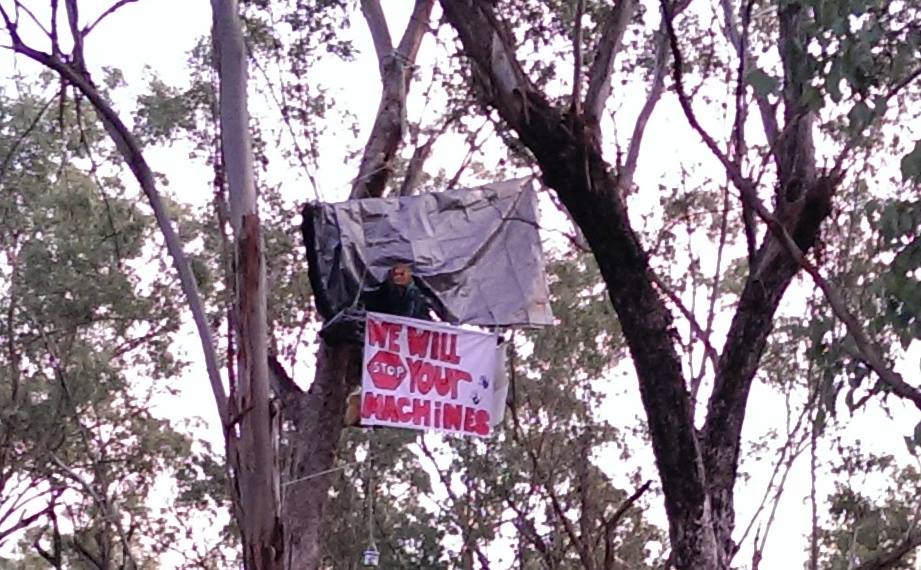
.
PART FOUR: INTO THE MAINSTREAM
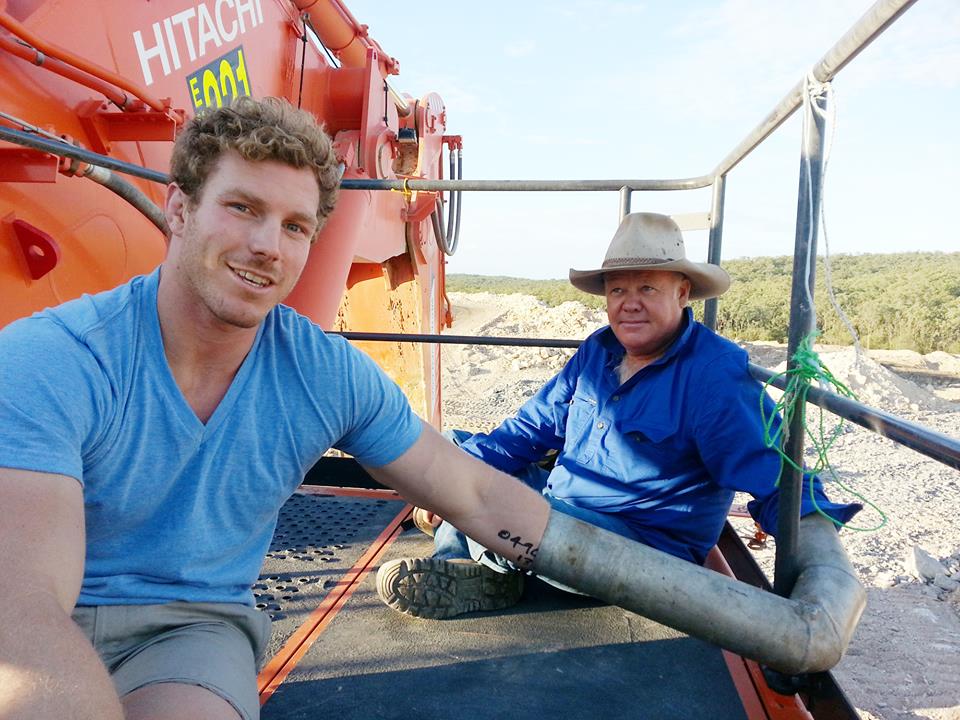
One of the most significant impacts FLAC has had on Australian environmentalism has been to normalise the tactic of civil disobedience. Non-Violent Direct Action had been used to protect the environment for decades by the time FLAC started, but it had often been confined to a small subculture – one that prided itself on being “forest ferals”.
FLAC, along with Lock The Gate who started around the same time and often collaborated, made a conscious effort to change that. Sure, we still had a few scruffy types amongst us. But as FLAC got going, arrestable actions were taken by urban professionals, local farmers, retired grandparents, 90 year old war veterans, religious groups, health workers, and plenty more folks from across the spectrum of humanity. Every environmental campaign in the country since has benefited in some way from FLAC’s work normalising direct action.
This has always been a feature of FLAC, but if there is a time that best exemplifies it, it was the summer of 2014/15. David Pocock – then Australian rugby union captain and now an independent senator – came to the Leard and locked himself to machinery alongside fifth generation local farmer Rick Laird. A month later, Luke O’Shea came straight from winning the golden guitar award at Tamworth’s country music festival and locked himself to a water truck. Luke had earlier filmed this video clip at Wando with a cast of FLAC backing singers.
.
PART FIVE: FLAC GOES TROPPO!
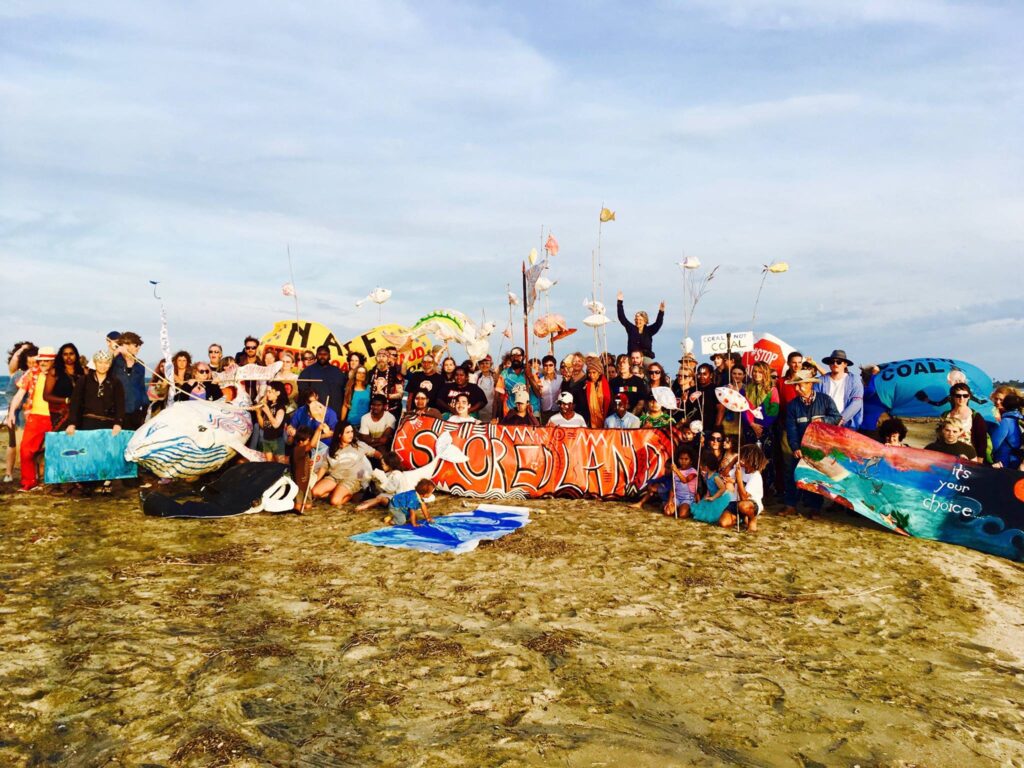
By late 2014, despite two years of dogged resistance from FLAC, Whitehaven were operating the Maules Creek mine. We still did more actions in the following few months, trying to stop forest being cleared before the winter break kicked in. But at this point, the conversations began about what to do next. This organism we had all worked so hard to build over two years – where do we take it from here?
It was decided that FLAC should go national, with autonomous FLAC groups wherever people wanted to set them up. They popped up doing disruptive actions in Brisbane and Melbourne, and quite a few people returned to Maules Creek in early 2016 to hit Whitehaven again. But eventually it was further north that we settled on a new climate frontline.
Hayley and Stevie originally moved north from Wando, to enjoy a bit of Queensland sunshine and begin work opposing Adani’s Carmichael megamine which was approved in 2014. They began under the name Reef Defenders, but before too long had inherited the name FLAC with a stingray replacing the Leard Forest bat as mascot. The first direct actions against Adani occurred in September 2017, when over 100 people gathered to block Adani’s Abbot Point port first on the road, then on the rail line. Adani by that point had certainly taken over from Maules Creek as the central focus of resistance to new coal mines in Australia, and FLAC settling in central Queensland enabled connections to be built with supportive locals, a close eye to be kept on Adani’s activities, and brought a frontline blockade element that really amplified the power of the campaign.
FLAC organised from a couple of different locations before settling on the property between Bowen and Collinsville that was known first as Nudja and then as Binbee. Just like Wando and Leard Forest before, Binbee was a special place because it was a home, a community, and a place of resistance and organising. It was where we lived together as a FLAC family – sharing meals, meetings and the emotional ups and downs of throwing your life into a direct action campaign. It was where we learnt to manage conflict and consensus, and discovered new skills and new sides of ourselves. It was a place where we got to see, at least on a small scale, the transformation we want to see in our world. And for a few years, we were a constant thorn in the side of Adani’s attempts to destroy our planet for their profits. During that time we saw Adani abandoned by key contractors, and their “megamine” delayed and downsized.
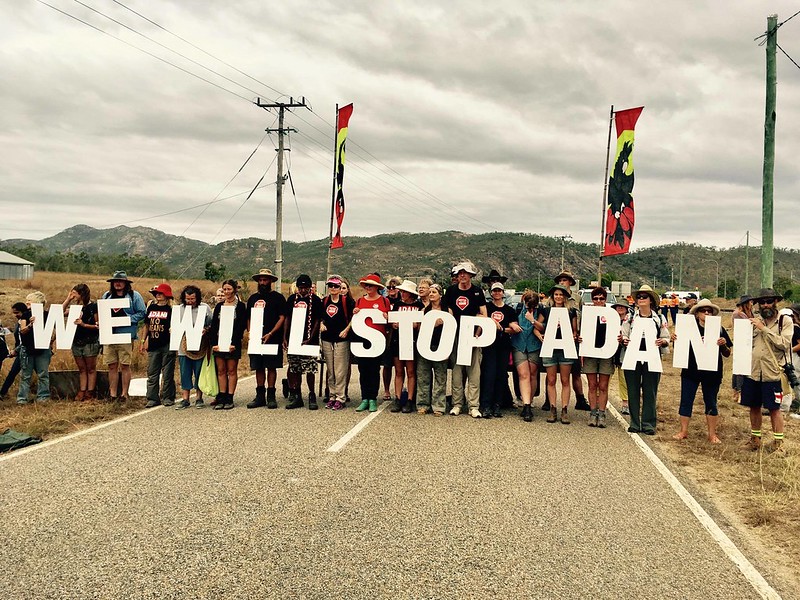
.
PART SIX: ADANI STARTS WORK – SO DOES FLAC
In October 2017, Adani finally started clearing land for the Carmichael rail line that was supposed to take their coal from the Galilee Basin to Abbot Point and across the ocean. Activists had already slowed down the construction and stopped their proposed port expansion. Now as Adani workers turned up for their first day on the rail corridor, they found FLAC there waiting – locked on to their machines. That week was full of disruptions for Adani, as each day we found new ways to blockade them.
And it was a sign of things to come for Adani, who were never quite able to just build a climate wrecking mine in peace. Internal leaks meant activists were blockading potential contractors before they had even been publicly announced. An Adani presentation at the Townsville Chamber of Commerce was waylaid by FLAC legends who were lying in hiding under the stage! When Adani finally began work on the mine site in August 2019, they met Amy and Reuben who had immobilised 17 machines with two monopoles and a banner reading “Adani starts clearing, we keep resisting”. On the day Adani hoped to clean up their trashed reputation with a brand change to Bravus, FLAC were at the front door of their head office with a giant papier mache turd saying “you can’t polish a turd”. This continued all the way up to when Adani finally began to ship out coal in late 2021, only to find FLAC blocking the line for each of their first three attempts.
The result of all these actions were that Adani were never able to claim any triumphant media moments – FLAC was always there to steal the show and make sure that the environmental cost and community opposition was mentioned amongst the PR jargon. But the other side to it is the work that had to be done by activists to do this. It required immense amounts of planning, research, adaptability and quick thinking. It also required one of FLAC’s particular attributes: the dedication to not just watch on from home, but to be there – to move your life to the frontlines in order to protect our planet.
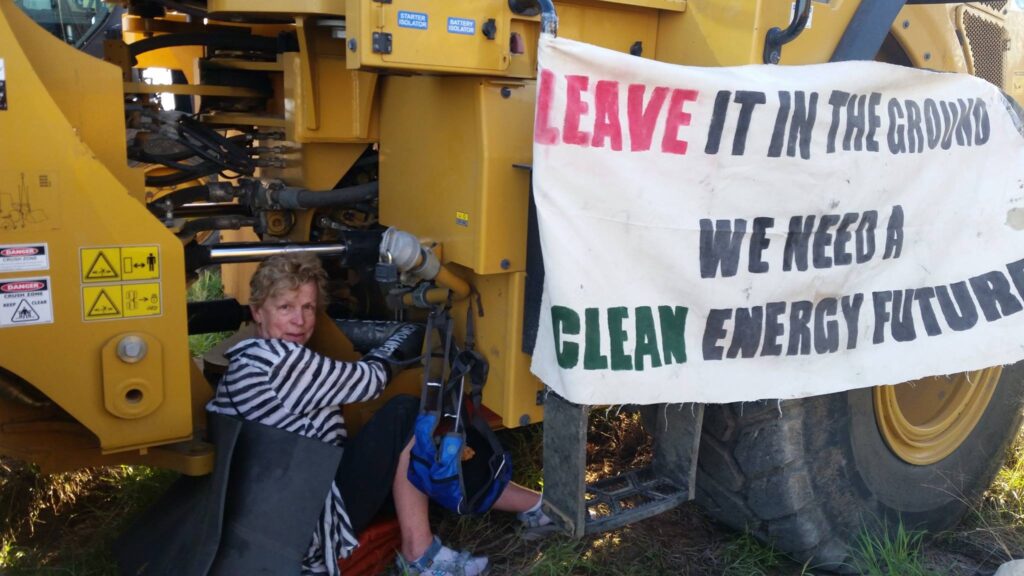
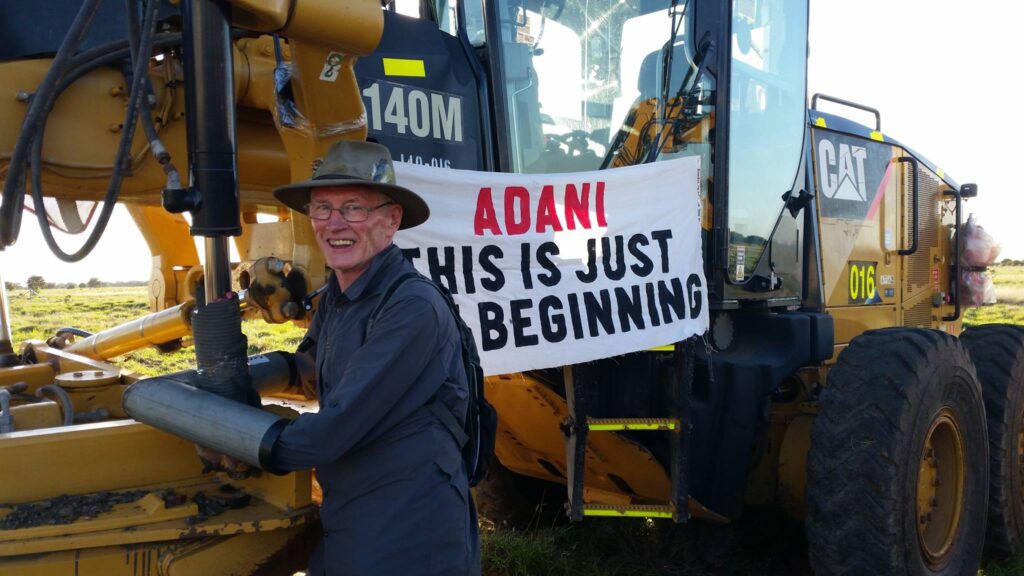
.
PART SEVEN: MUSICIANS RISING
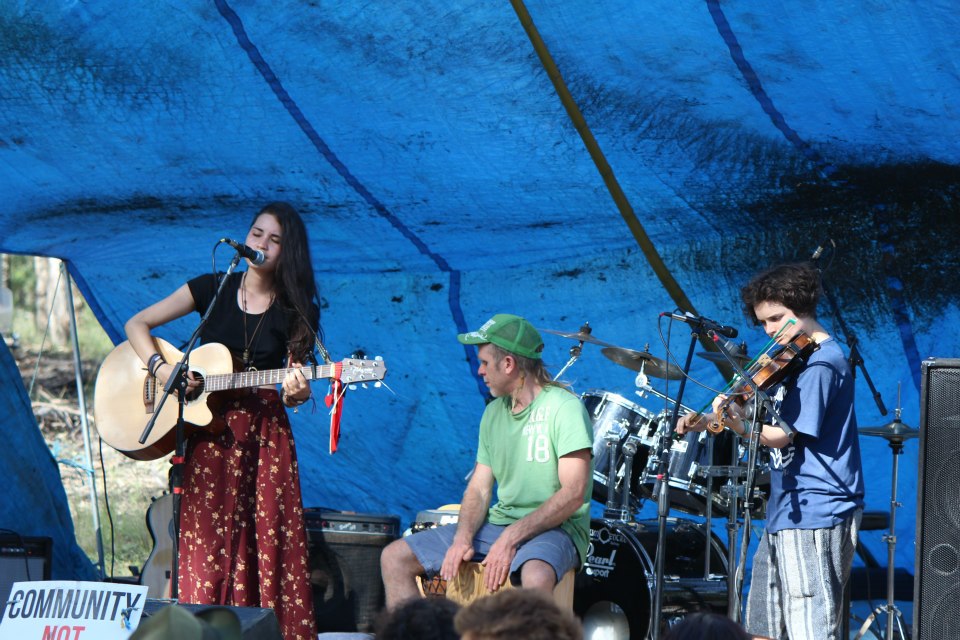
Early on in the life of FLAC, much brainpower was expended on the problem of how to get people to come to the frontline. We were six hours’ drive from the nearest city, where few people had ever heard of the Leard Forest or even the nearby towns. Someone came up with a great idea: “let’s have a concert!” And so the Leard Forest Listen Up was born. Musicians came to play their songs on a makeshift stage under a tarpaulin, and people came to listen – some just for the music but staying to find out about the campaign. So there were more concerts. Bands would travel from all around the country. By early 2015, FLAC was organising a full on protestival called Bat Attack, headlined by Aboriginal rock legends Coloured Stone.
There were songs written specifically for Maules Creek (“Whitehaven Coal, Where is your Soul” being the title of an early one), and fundraiser concerts held all over the country. In Queensland, gigs put on by the Maules Creek Brisbane Action Group featured future star musicians and helped develop a steady stream of Brisbanites travelling down to the Leard.
After FLAC moved north, the use of music continued – the REACT protestival in 2019 was followed by Musicians Rising – a couple of events bringing national stars like John Butler and Lisa Mitchell to perform in the shed at Camp Binbee.
Music was also a regular and vibrant part of camp life. Songs were composed and performed around the campfire, and singalongs held to keep the spirits up on the picket line. It’s hard to encapsulate the role that art and culture play in forming individuals, communities and political consciousness. But however you look at it, music has been an important part of Frontline Action on Coal, and FLAC has been vital for musicians who have been inspired and given an opportunity to link their art to frontline climate action. In December 2019, FLAC even released our own album “Rock’n’Roll for Blockin’ Coal” – a compilation of artists who had been at Camp Binbee adding their voices to the sweet song of climate resistance.
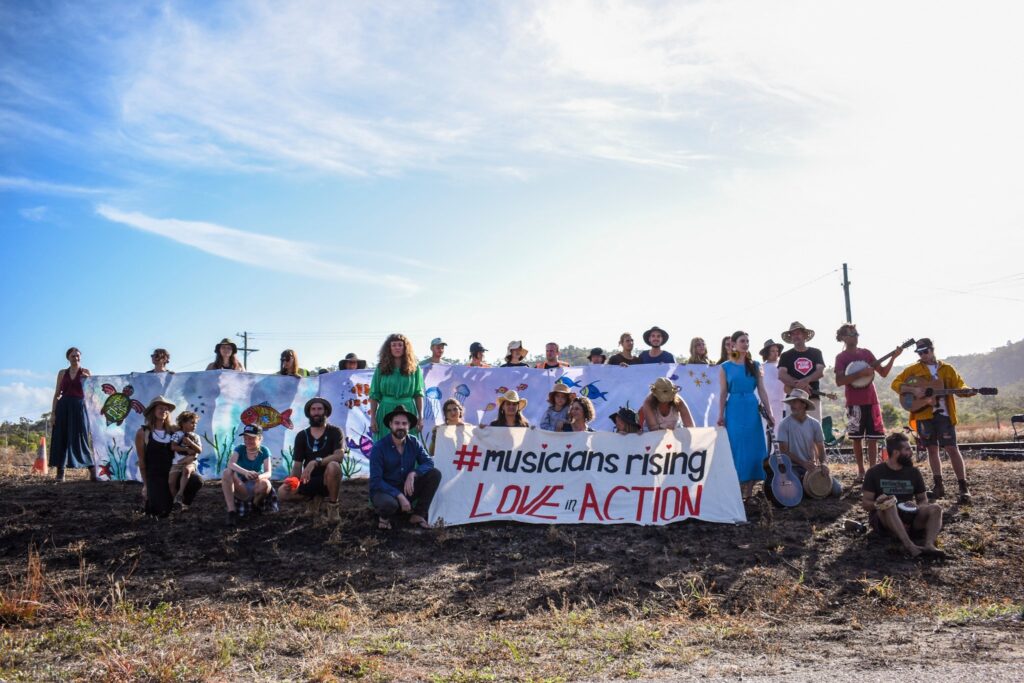
.
PART EIGHT: WORKING WITH THE MOB
Anyone trying to run any kind of social justice or environmental campaign in Australia needs to reckon with the nation’s original injustice – the theft of this land from its traditional inhabitants.
And so FLAC from the beginning has made a concerted effort to forge relationships with the Traditional Owners of wherever we have been based. At Maules Creek it was the Gomeroi people. We were both trying to protect that country, and we often sat together at camp, sharing meals. We drew up a document with some understandings about how the two groups would negotiate our differences and work together. Aunty Dolly and Uncle Mitch would happily speak to the media for FLAC actions, or sometimes, like the link below, Gomeroi people were the ones taking direct action themselves. A couple of times they held their own protest marches too, and FLAC loaded everyone into vehicles to drive to Gunnedah and join them on the streets.
When we moved up to Queensland, the same effort was made – with the Juru people whose land was threatened by the expansion of Abbot Point, with the Birri people where our home at Camp Binbee was situated, and with the Wangan and Jagalingou people who were trying to stop Adani building a mine on their land.
Despite best intentions, the process of coming together hasn’t always been easy – though we sure learned a lot. The differences in culture, aims, tactics and communication styles were often sticking points.
The thing with being on the frontlines is that you are physically there. You don’t get to just say an Acknowledgement of Country then tick a box of Indigenous solidarity. Being there on country, or living together in a camp, means building a relationship. And like any relationship, it has its complications and lessons to be learnt – the process of decolonising our own minds and ways of operating is a constant practice.
But like I said at the start, any struggle for a better Australia means facing up to the injustices historically and currently done towards Aboriginal people. But working towards a better future means trying, learning, and hopefully building the foundations for a world where everyone works for the good of all regardless of racial or cultural differences. And ultimately we at FLAC are better off for putting in the work, having been blessed with rich relationships, learned a lot about loving and protecting country, and had the honour to work alongside some inspiring First Nations activists and campaigns which are fighting the good fight and making a big impact.
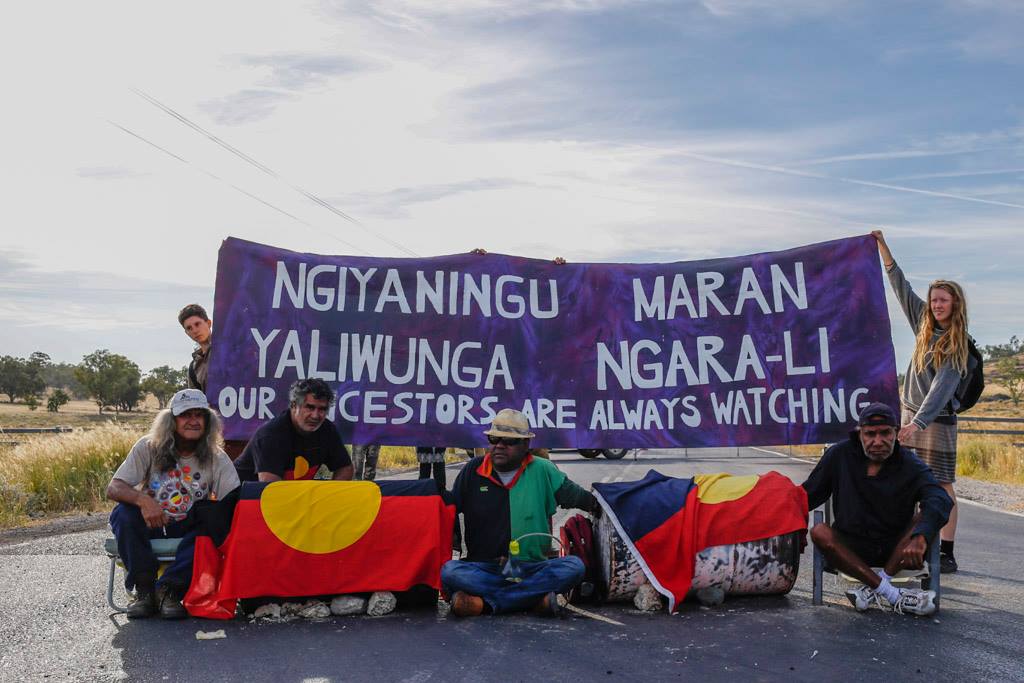
.
PART NINE: THE ACTIVIST UNIVERSITY
Throughout FLAC’s decade of existence, we have been blessed with many experienced and highly skilled activists. And we have been doubly blessed that these folks did not see their skills as something to be kept to themselves, but instead went out of their way to share the skills with others.
In fact, go back to the very first post on FLAC’s website, and it’s an announcement of a “skillshare” at Maules Creek. This word – seldom used in most contexts – was a regular part of the lexicon at the various FLAC camps. Everybody who entered those camps was given NVDA training to learn about what we do. When designating the various jobs there was always encouragement for someone to “shadow” a role and observe how it is done. But camp life was a constant place of learning – there was a permanent chalkboard where anyone could write up skills they had to share, with no stipulation they had to have anything to do with the campaign.
Some of the skills we learnt at FLAC – like welding, photography or group facilitation – are easily transferable to other contexts. Others – like rigging treesits, police liaison, or camp kitchen cooking for 50 people with various dietary requirements – are more specialised. But all of them involved us stepping out of our comfort zone and having the opportunity to learn something new.
It’s actually not that often in our adult lives we get the opportunity to do that. In our career, tasks are specialised, directed from above, maybe assigned to us based on assumptions about us that aren’t true, and above all are restricted to what will make a profit rather than any real reflection of our passions and abilities or the world’s needs. In contrast to that, being immersed in FLAC’s community of resistance is an amazing way to learn new skills and new sides of ourselves.
But that’s also not the whole story. The activist university at FLAC didn’t just affect the individuals who came through the camps. The broader activist scene was also the beneficiary. People took the skills they had learned at FLAC and put them to use in direct action campaigns to stop coal seam gas extraction, protect forests, defend refugee rights, and agitate for climate action on city streets and frontlines around the country and the world.
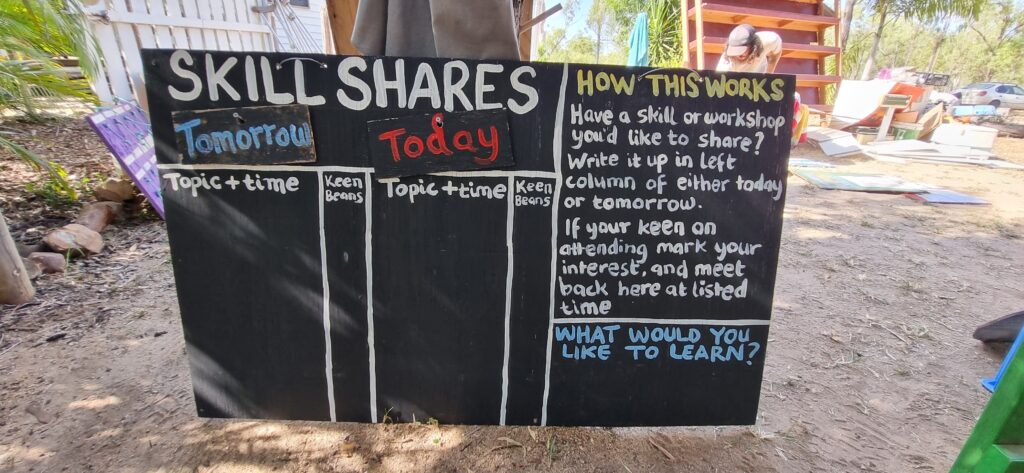
.
PART TEN: NOT JUST HISTORY
Despite more than four years of direct action disrupting Adani, towards the end of 2021 it became clear that the Carmichael mine was about to start shipping out coal. It was frustrating and saddening, but that didn’t mean it was time to stop. We made sure that when coal finally came out of that mine we would be there again to rain on Adani’s parade and to send a message – every bit of resistance to fossil fuel destruction is vital to protect our planet. The climate movement can’t afford to give up, and we don’t intend to.
Over the last couple of weeks, we have been looking back at the first decade of Frontline Action on Coal’s existence. But we haven’t done that to just reminisce or glorify the past. We’ve done it because ten years of organising and acting for our climate is an achievement to be celebrated, and it’s worthwhile to look back at what we have done and to recognise the fruits of all that work – we maybe didn’t stop the Maules Creek or Carmichael coal mines, but we built a community and a movement that lives on.
The history of FLAC is a tale of people who refused to let someone else write our story for us. We didn’t want the mining industry ruining our planet just because they had the money and power to do it, and we didn’t want mediators telling us how the political system works and what the role of everyday people is in it.
Nobody owns Frontline Action on Coal, and over the years literally thousands of people have stood up and acted for FLAC as the moment demanded. It was a small group that laid the foundations, but a vast crowd that has subsequently come through and taken responsibility for it. The end of the Maules Creek campaign could have been the end of FLAC, but others saw a need in Queensland and revived it.
There have been some incredible stalwarts who have spent a long time and put a lot of work in on the frontlines, but FLAC was never about a few special people – it was all of us that made FLAC.
So that brings us to today. The end of our first decade coincides with the time to move on from our beloved home at Camp Binbee. It’s not clear what our future holds, but we know that FLAC will live on – in the hearts and actions of all of us who were part of it, in the legacy it leaves in the Australian environment movement, and in the next stage in our journey – whatever that is. We look forward to sharing it with you all, and to continuing to work together for our climate and our dreams of a better world. See you on the frontlines!

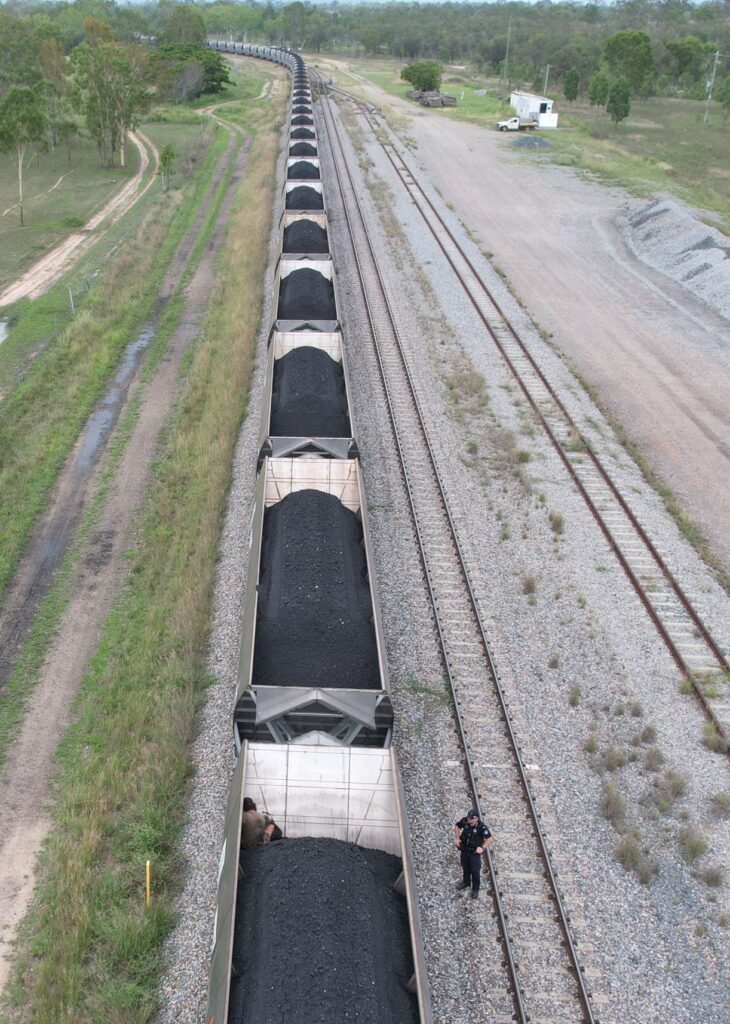
– Andy Paine

Recent Comments